When the New car shortage began, dealers turned toward Used units to fulfill high levels of consumer demand. For months, dealers have hustled to acquire Used vehicles in order to capitalize on their record-breaking retail prices and transaction margins.
The LotLinx Research Lab has kept a close eye on the latest Used inventory trends throughout these market shifts. Recent reports have identified a number of indicators that Used inventory days supply is increasing, consumer interest is softening, and dealers are responding by increasing markdowns per unit.
Key Insights:
1. Dealerships are acquiring more inventory than they are selling. Used vehicle stocking levels have moved into the positive territory compared to Q4 last year.
2. Days supply has increased by approximately 11 days since then.
3. Although PVR has remained strong, there is increasing stress in the markets. Whereas dealers made far fewer markdowns in January, they have resorted to increasing the size of markdowns to move inventory.
4. The overall ramp up of prices has increased by $2,000/unit since mid-December during a trend of softening demand, whereas distressed inventory is being discounted $3,000.
5. LotLinx’s proprietary index of days-not-seen (VINVisibility) has steadily decreased since December, indicating more vehicles are being seen each day on dealer websites but more are staying on the sidelines.
Savvy Dealers Should Consider Taking Control:
– Adjusting Used vehicle prices to late January levels
– Assure adequate exposure on each car in inventory to avoid the “not-seen” trap
Take a closer look at the ebb and flow of used vehicle listings:
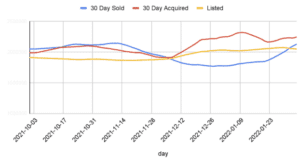
The proprietary LotLinx Data Network analyzes real dealership inventory to track the number of listed and sold units on lots across the country. In December 2021, Used vehicle stocking levels moved into positive territory year over year. As both New and Used dealership inventories grow, the number of units sold is moving disproportionately to the number of units listed, meaning dealership sales paces are slowing despite an uptick heading into February.
Moving forward, LotLinx’s Machine Learning forecasts that a typical dealer holding 70 units in stock will see a change (+/-) of around 10 units by the end of April. The average dealer will most likely to be holding 76 units in stock.
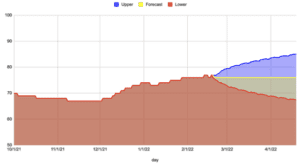
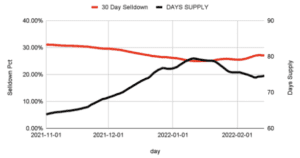
Take a closer look at the days-on-lot, markdown, and sales trends that outline this pattern and can be used to inform your Used inventory business decisions:
This trend is punctuated by a steady increase in dealership days supply, meaning it is taking dealers a higher number of days to sell through their inventory. Similarly, the 30-Day Selldown Percentage, a measure of the percent of inventory sold within the first 30 days, has also dropped.
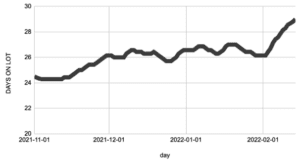
A slowing sales pace is especially prominent for Used inventory. Looking at a 90-day variance, the average unit’s days-on-lot is approaching a 5+ day increase, once again surpassing New units’ DOL. The number of days a Used unit sat on the dealership’s lot before selling has reached a 30-day average.

It is possible that the slowed pace could be a result of decreased consumer interest. The LotLinx Research Lab uses a “days-not-seen” metric (VINVisibility) as a measure of daily inventory exposure.
The average number of days-not-seen has begun to steadily decrease since December, moving from 66% to 61% of inventory not being viewed on a daily basis. When compared to sales rates, it indicates that although more inventory is being seen, more of these consumers are sitting on the sidelines. A vehicle not seen over consecutive days is one of many factors that increase days-on-lot and the probability of a markdown.
In regards to markdowns, the proprietary VINVisibility index has improved since the beginning of the year. However, most dealers should still be concerned that 39% of their inventory is not seen daily BEFORE pushing the price reduction button in their DMS.
It may also be surprising to dealers that 100% of their PAID advertising is focused on only 9% of the inventory.
Markdowns are not the solution
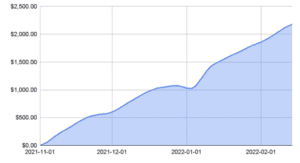
For months, the inventory shortage gave dealers relief from relying on price markdowns. As consumer demand remained high, dealers were able to successfully sell aged units at record-breaking prices. But, as consumer demand begins to cool, the average price of a Used vehicle has increased since early November by $2,000. Interestingly, markdowns for distressed inventory are averaging over $3,000, whereas fresh is below $2,000.
Profit per vehicle is strong, but is it sustainable? Dealers are going to have far less elasticity in pricing as supply catches up to demand and consumers are no longer willing to spend above listing price.
The data shows that the average value of a Used inventory markdown has jumped noticeably, proving dealers are once again turning to price cuts to incentivize buyers. The average markdown for a unit with 15 to 45 days-on-lot is $1,747, while units with over 45 days tend to see $3,018 markdowns. In addition to a per-markdown increase, the cumulative value of Used inventory markdowns has steadily outpaced New units for months.
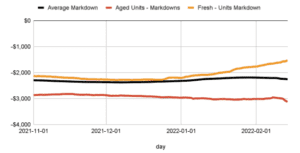
On average, a dealer will wait 7 days before marking down a vehicle, but it is rare that a single markdown will impact that vehicle’s ability to sell. Most units (that have a markdown) see 3 markdowns before a sale. This is slightly down from the high of 5 markdowns in September 2021. Altogether, this means the average dealer could miss out on over $1,200 in margin on a single vehicle.
At this rate, the potential for wasted profit is incredibly high. If dealers fall back into old habits, the value and frequency of these markdowns are only going to grow.
Reducing a vehicle price is not the only solution to stimulate sales and maintain Used inventory profitability. Dealers looking to avoid significant profit loss in the spring selling season should be conscious of their pricing and markdown habits, and ensure adequate exposure on each car to avoid the lack of visibility trap.
Get started by actively monitoring these market trends, and request a complete risk analysis of your dealership to see how your store stacks up. Then, meet with a LotLinx retailing expert to design a plan to best tackle the changing Used inventory market.
Schedule an in-person meeting at NADA 2022, or get started ASAP.